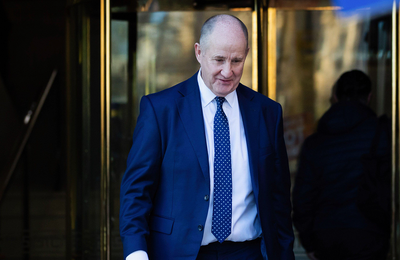Eighteen. For the past 12 months, 18 has been the number most frequently mentioned in media reports of voting intentions polls. At almost any time since the start of last year, an average of recent polls has produced a Labour lead of 18 per cent or something very close to it. It has been a quick and useful way of reporting the state of play between the two main parties. But is it right?
One big advantage to polling averages is that they dampen the random variations that no pollster can avoid with their standard samples of 1,000-2,000. Labour’s leads in individual polls in 2023 ranged from 10 per cent to 30 per cent. It would have been easy to tell a story of huge swings in the public mood. The reality is that support for Labour and the Conservatives barely moved throughout the year.
But is 18 per cent the right figure for the gap between them? This is where the plot thickens. The chart below shows a different way of looking at the averages. It gives the separate 2023 averages for each of 14 pollsters. These retain the benefit of dampening the random ups and downs of individual polls.
As the chart shows, the 14 companies vary quite a lot. Opinium, which reported the 10 per cent lead in September, is usually at the lower end of the range, while PeoplePolling, which put the lead at 30 per cent in November, tends to report among the biggest Labour leads.
Each polling company has its own way of trying to make its figures reflect Britain’s electorate. They vary slightly in how they design their samples and weight their raw numbers. Some variation in their figures for each party is inevitable.
There is, however, a bigger issue. As the chart shows, YouGov features at both ends of the chart, with an average of a 21 per cent lead in its polls over the year for the Times, and just 13.5 per cent in its recent controversial survey in the Daily Telegraph. I have included this in the chart, as its sample was 14,000, so should be immune from excessive random error. The point is that this time YouGov arrived at its voting figures by a different route from normal—and ended up with very different figures.
How come? It’s because the very concept of “voting intention” has two distinct meanings. One choice is the purity option: How many people would express their support for each party if we managed to contact all 47m electors throughout Britain? The alternative is the reality option: How many people would actually vote for each party if a general election were held today?
The two sets of figures from YouGov demonstrate the difference. YouGov’s regular polls typically take the purist approach. These produced an average Labour lead last year of 21 per cent. These surveys found that around one-third of people who voted Conservative in 2019 now say they don’t know or won’t vote. That is getting on for five million out of the 14m who delivered Boris Johnson his big victory four years ago. Like most polling companies, YouGov excludes them from their regular voting intention figures for the Times.
But would all five million really sit out an actual election? In its separate poll published in the Daily Telegraph, YouGov switched from the purity to the reality approach. It estimated how many of the don’t knows would in fact vote, and who for. It also applied what it describes as a sophisticated “multilevel model” to estimate the likely turnout for each type of voter. This pulled Labour’s lead down sharply to 13.5 per cent. (The Telegraph’s story failed to point this out. It emphasised the seat-by-seat projection of a Labour landslide. Other pollsters using similar seat-by-seat methods have also reported massive Labour victories. I have my doubts about those calculations; but that’s another story, and another blog.)
Opinium is one company that adopts the reality approach. This is why it regularly reports lower leads than most other companies. Its new year poll for the Observer is typical. Its unadjusted “purity” figures showed Labour on 44 per cent, 20 points ahead of the Conservatives. But its “reality” adjustments—to turnout, don’t knows etc—reduced Labour’s support by three percentage points, and added the same amount to the Tories. The outcome: Labour’s lead as reported by the Observer, six points lower at 14 per cent.
Stonehaven is a new entrant to published polls. It also adopts a reality approach, allocating to each respondent their probability of voting at all, and for which party. Including results from its unpublished polls, its 2023 average is at the lower end of the scale: a Labour lead of 15 per cent.
To return to the question at the start of this blog: was Labour’s true lead last year 18 per cent, as the year-long, 14 company, 400-poll average showed? To give a sensible answer, we must separate out “purity” from “reality” results. Labour’s “pure” lead was probably 18-20 per cent. This would put Labour on course for a huge victory and justify Tory fears of a catastrophic defeat.
However, if we adopt the “reality” approach, Labour’s lead is significantly lower: around 13-15 per cent, after allowing for don’t knows and other factors. This is still not a true prediction, for it does not allow for the ways in which a six-week election campaign might change voters’ minds. In 2017, no pollster could predict the way Theresa May’s rating, and her hopes for a clear victory, collapsed two weeks before polling day over her plans for social care. Outside an election campaign, the point remains that “pure” polling numbers tell us much about the current anti-Tory mood of the electorate, but “reality” polls tell us more about its electoral implications.
That, then, is my best estimate of the real baseline at the start of election year. Some polls have shown Labour’s lead widening this month; but others have not. At the very least, there is no sign yet of a Tory recovery. A Labour lead of 13-15 per cent would give Keir Starmer a comfortable majority, probably approaching 100. But past Conservative governments at the end of a full term have consistently gained ground in the months approaching election day. If history repeats itself—a great big, neon-lit big IF, of course—a closer result is perfectly possible. That is the story the Telegraph should have told.














